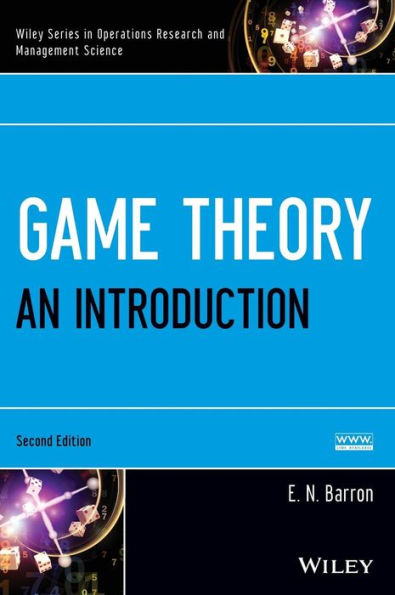Table of Contents
Preface for the Second Edition xi
Preface for the First Edition xv
Acknowledgments xvii
Introduction 1
1 Matrix Two-Person Games 5
1.1 The Basics 5
Problems 16
1.2 The von Neumann Minimax Theorem 18
1.2.1 Proof of von Neumann’s Minimax Theorem (Optional) 21
Problems 24
1.3 Mixed Strategies 25
1.3.1 Properties of Optimal Strategies 35
1.3.2 Dominated Strategies 38
1.4 Solving 2 × 2 Games Graphically 41
Problems 43
1.5 Graphical Solution of 2 × m and n × 2 Games 44
Problems 50
1.6 Best Response Strategies 53
Problems 57
1.6.1 MapleTM/Mathematica R 58
Bibliographic Notes 59
2 Solution Methods for Matrix Games 60
2.1 Solution of Some Special Games 60
2.1.1 2 × 2 Games Revisited 60
Problems 64
2.2 Invertible Matrix Games 65
2.2.1 Completely Mixed Games 68
Problems 74
2.3 Symmetric Games 76
Problems 81
2.4 Matrix Games and Linear Programming 82
2.4.1 Setting Up the Linear Program: Method 1 83
2.4.2 A Direct Formulation Without Transforming: Method 2 89
Problems 94
2.5 Appendix: Linear Programming and the Simplex Method 98
2.5.1 The Simplex Method Step by Step 101
Problems 108
2.6 Review Problems 108
2.7 Maple/Mathematica 109
2.7.1 Invertible Matrices 109
2.7.2 Linear Programming: Method 1 110
2.7.3 Linear Programming: Method 2 111
Bibliographic Notes 113
3 Two-Person Nonzero Sum Games 115
3.1 The Basics 115
Problems 123
3.2 2 × 2 Bimatrix Games, Best Response, Equality of Payoffs 125
3.2.1 Calculation of the Rational Reaction Sets for 2 × 2 Games 125
Problems 132
3.3 Interior Mixed Nash Points by Calculus 135
3.3.1 Calculus Method for Interior Nash 135
Problems 143
3.3.2 Proof that There is a Nash Equilibrium for Bimatrix Games (Optional) 146
3.4 Nonlinear Programming Method for Nonzero Sum Two-Person Games 148
3.4.1 Summary of Methods for Finding Mixed Nash Equilibria 156
Problems 158
3.5 Correlated Equilibria 159
3.5.1 LP Problem for a Correlated Equilibrium 165
Problems 166
3.6 Choosing Among Several Nash Equilibria (Optional) 167
Problems 172
3.6.1 Maple/Mathematica 173
3.6.2 Mathematica for Lemke–Howson Algorithm 173
Bibliographic Notes 175
4 Games in Extensive Form: Sequential Decision Making 176
4.1 Introduction to Game Trees—Gambit 176
Problems 189
4.2 Backward Induction and Subgame Perfect Equilibrium 190
Problems 193
4.2.1 Subgame Perfect Equilibrium 194
4.2.2 Examples of Extensive Games Using Gambit 200
Problems 209
Bibliographic Notes 212
5 n-Person Nonzero Sum Games and Games with a Continuum of Strategies 213
5.1 The Basics 213
Problems 235
5.2 Economics Applications of Nash Equilibria 242
5.2.1 Cournot Duopoly 243
5.2.2 A Slight Generalization of Cournot 245
5.2.3 Cournot Model with Uncertain Costs 247
5.2.4 The Bertrand Model 250
5.2.5 The Stackelberg Model 252
5.2.6 Entry Deterrence 254
Problems 256
5.3 Duels (Optional) 259
5.3.1 Silent Duel on [0,1] (Optional) 262
Problem 266
5.4 Auctions (Optional) 266
5.4.1 Complete Information 271
Problems 272
5.4.2 Incomplete Information 272
5.4.3 Symmetric Independent Private Value Auctions 275
Problem 286
Bibliographic Notes 287
6 Cooperative Games 288
6.1 Coalitions and Characteristic Functions 288
Problems 307
6.1.1 More on the Core and Least Core 310
Problems 317
6.2 The Nucleolus 319
6.2.1 An Exact Nucleolus for Three-Player Games 327
Problems 333
6.3 The Shapley Value 335
Problems 347
6.4 Bargaining 352
6.4.1 The Nash Model with Security Point 358
6.4.2 Threats 365
6.4.3 The Kalai–Smorodinsky Bargaining Solution 377
6.4.4 Sequential Bargaining 379
Problems 384
Review Problems 386
6.5 Maple/Mathematica 386
6.5.1 Finding the Nucleolus One Step at a Time 386
6.5.2 Mathematica Code for Three-Person Nucleolus 391
6.5.3 The Shapley Value with Maple 393
6.5.4 Maple and Bargaining 393
Bibliographic Notes 394
7 Evolutionary Stable Strategies and Population Games 395
7.1 Evolution 395
7.1.1 Properties of an ESS 402
Problems 408
7.2 Population Games 409
Problems 428
Bibliographic Notes 430
Appendix A: The Essentials of Matrix Analysis 432
Appendix B: The Essentials of Probability 436
Appendix C: The Essentials of Maple 442
Appendix D: The Mathematica Commands 448
Appendix E: Biographies 463
Problem Solutions 465
References 549
Index 551









